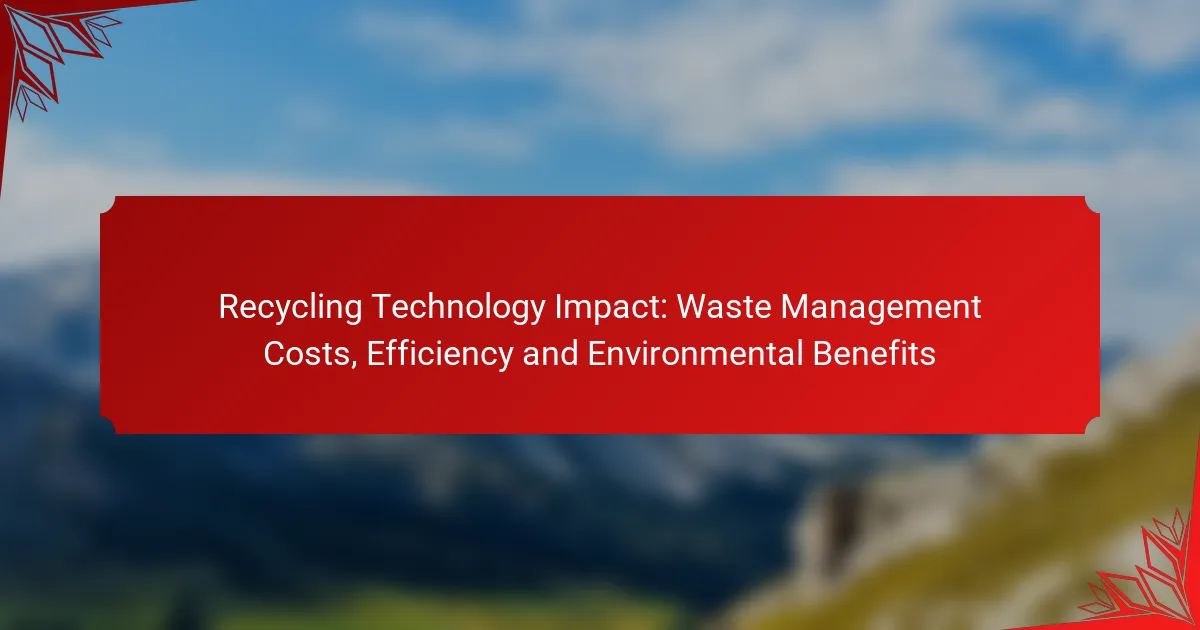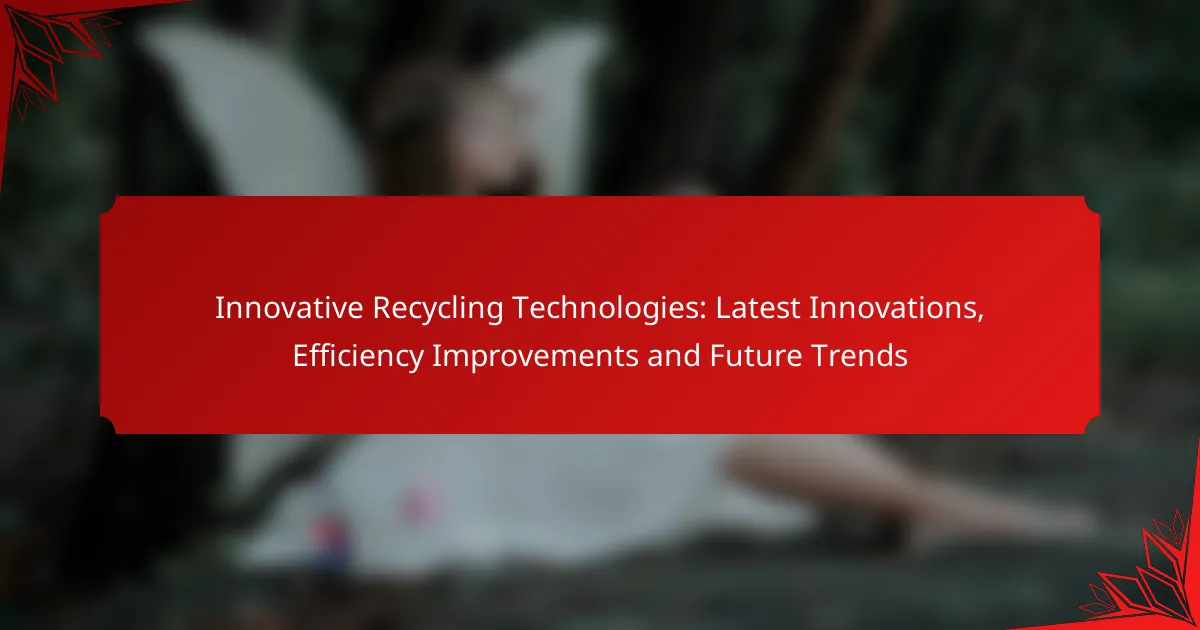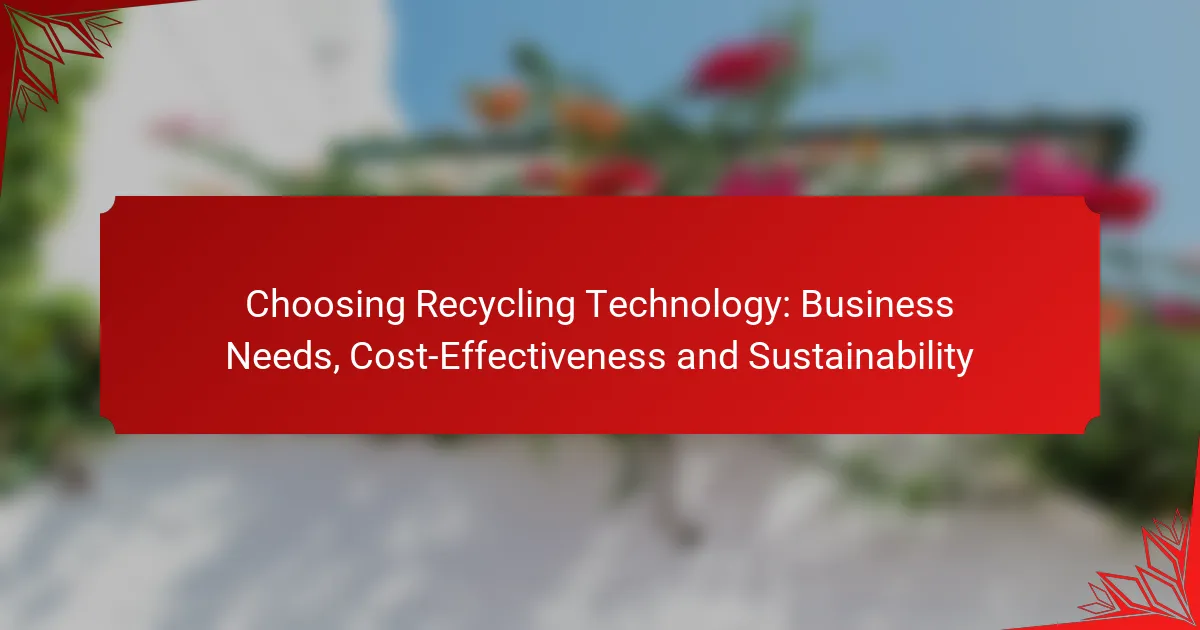Recycling technology plays a crucial role in transforming waste management by lowering costs and enhancing efficiency. By automating processes and improving sorting capabilities, these innovations not only reduce operational expenses but also increase the volume of materials recycled. Additionally, they contribute to significant environmental benefits, such as reduced carbon emissions and improved biodiversity, by minimizing the need for raw resource extraction.
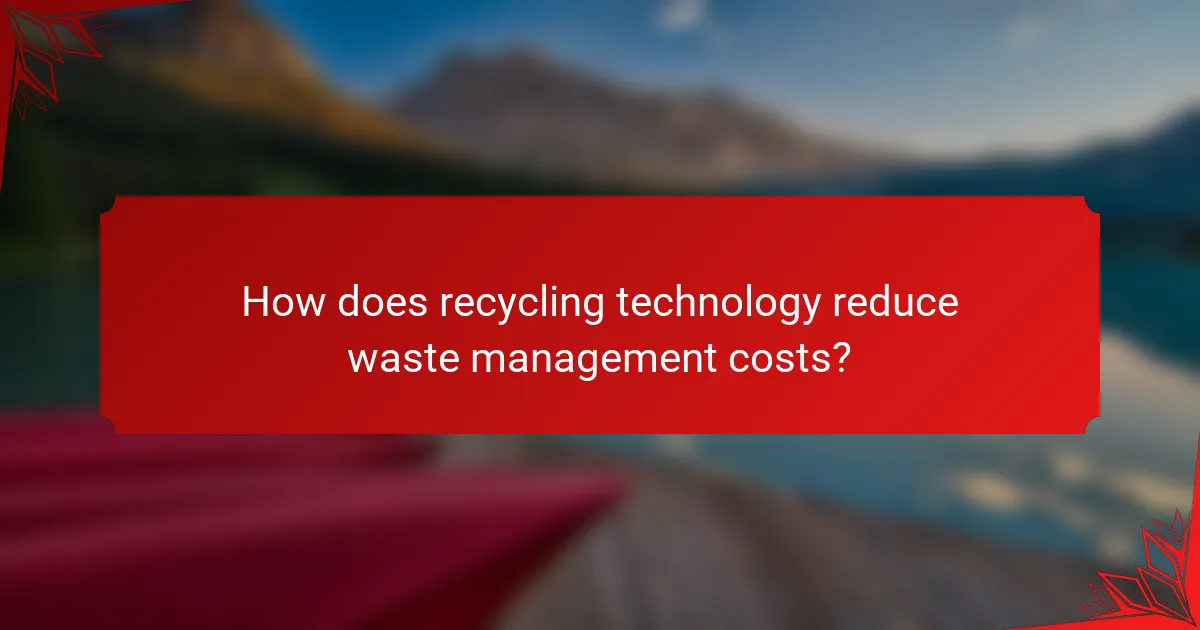
How does recycling technology reduce waste management costs?
Recycling technology significantly lowers waste management costs by improving efficiency and maximizing resource recovery. By automating processes and enhancing sorting capabilities, these technologies help reduce labor and operational expenses while increasing the volume of materials that can be recycled.
Lower operational expenses
Advanced recycling technologies streamline waste processing, which leads to lower operational expenses. Automated sorting systems, for example, reduce the need for manual labor, cutting down on wages and training costs. Additionally, energy-efficient machinery can lower utility bills, contributing to overall savings.
Implementing these technologies can result in savings of up to 30% in operational costs, depending on the scale of the facility and the types of materials processed. This efficiency not only benefits waste management companies but can also translate to lower fees for consumers.
Increased material recovery rates
Recycling technology enhances material recovery rates by improving the accuracy and speed of sorting recyclable materials. High-tech systems can identify and separate various materials more effectively than traditional methods, ensuring that a higher percentage of waste is diverted from landfills.
For instance, modern optical sorting machines can achieve recovery rates of 90% or more for certain materials, such as plastics and metals. This not only reduces waste but also increases the supply of recycled materials available for manufacturing, which can lower costs for producers.
Case study: Waste Management Inc.
Waste Management Inc. implemented advanced recycling technologies across its facilities, resulting in significant cost reductions and improved efficiency. By adopting automated sorting systems, the company reported a 25% decrease in operational costs within the first year.
Furthermore, their material recovery rates improved from approximately 60% to over 85%, allowing them to recycle more materials and reduce landfill waste. This case illustrates how investing in recycling technology can yield substantial financial and environmental benefits for waste management operations.

What are the efficiency benefits of recycling technology?
Recycling technology significantly enhances efficiency in waste management by streamlining processes and improving resource recovery. These advancements lead to reduced operational costs and better environmental outcomes.
Faster processing times
Recycling technology accelerates the processing of materials, allowing facilities to handle larger volumes of waste in shorter periods. Automated systems can reduce processing times to mere minutes, compared to traditional methods that may take hours or even days.
For example, advanced shredders and conveyor systems can quickly break down and transport materials, minimizing delays and increasing throughput. This efficiency not only lowers labor costs but also allows for quicker turnaround in recycling operations.
Improved sorting accuracy
Modern recycling technologies utilize sophisticated sorting mechanisms, such as optical sensors and AI-driven systems, to enhance the accuracy of material separation. These innovations can achieve sorting efficiencies exceeding 95%, significantly reducing contamination rates.
Accurate sorting is crucial for maximizing the quality of recycled materials, which in turn increases their market value. Facilities that implement these technologies often see a decrease in the costs associated with reprocessing contaminated materials.
Example: TOMRA Sorting Solutions
TOMRA Sorting Solutions exemplifies the impact of advanced recycling technology on efficiency. Their systems employ state-of-the-art sensors and machine learning algorithms to identify and sort various materials with high precision.
By using TOMRA’s technology, recycling facilities can improve their operational efficiency, reduce waste, and enhance the quality of output materials. This not only benefits the environment but also aligns with regulatory standards for waste management in many regions.
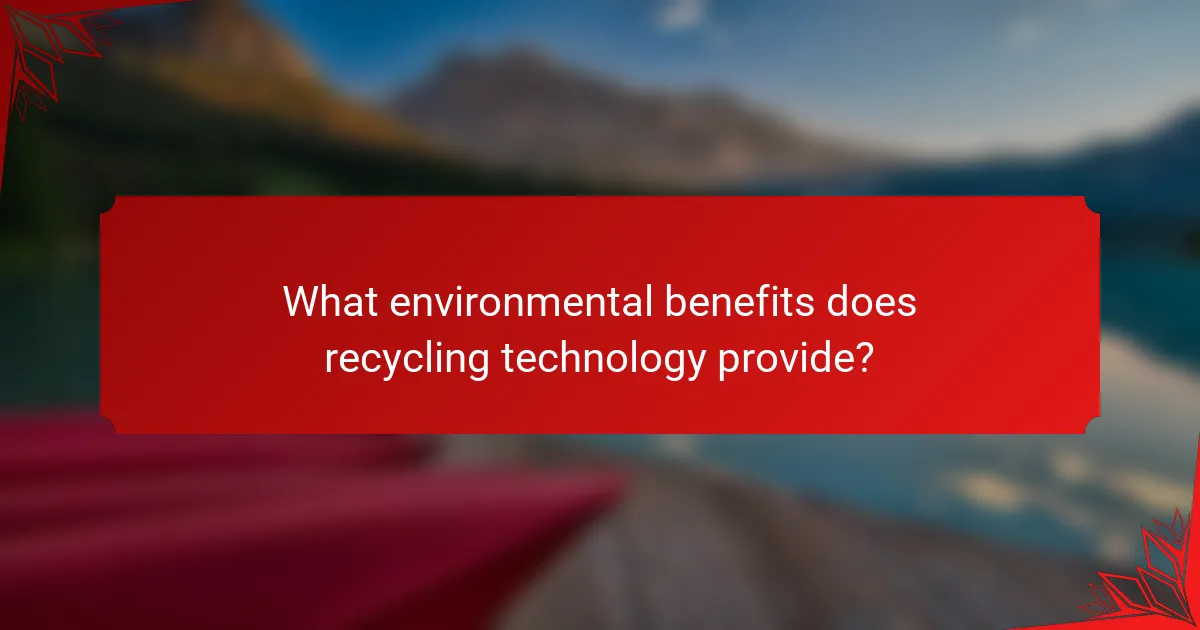
What environmental benefits does recycling technology provide?
Recycling technology offers significant environmental benefits by reducing waste, lowering carbon emissions, and positively impacting biodiversity. These advantages stem from the efficient processing of materials, which minimizes the need for raw resource extraction and promotes sustainable practices.
Reduction in landfill waste
Recycling technology plays a crucial role in reducing landfill waste by converting discarded materials into reusable resources. For instance, recycling paper can divert millions of tons from landfills each year, significantly decreasing the volume of waste that requires disposal.
By implementing effective recycling programs, communities can achieve diversion rates of 30-50% or more, depending on local policies and participation. This not only alleviates pressure on landfill sites but also extends their lifespan, reducing the need for new landfill construction.
Lower carbon emissions
Recycling technology contributes to lower carbon emissions by decreasing the energy required for producing new materials. For example, recycling aluminum saves up to 95% of the energy needed to create aluminum from raw bauxite, leading to substantial reductions in greenhouse gas emissions.
In addition, recycling reduces the need for transportation of raw materials, further cutting emissions. Communities that prioritize recycling can see a measurable decrease in their overall carbon footprint, aligning with global efforts to combat climate change.
Impact on biodiversity
Recycling technology positively impacts biodiversity by reducing the demand for raw materials, which often leads to habitat destruction. By recycling materials, we lessen the need for mining, logging, and other resource extraction activities that threaten ecosystems and wildlife.
Moreover, sustainable recycling practices help maintain natural habitats, supporting the preservation of various species. Communities that adopt robust recycling initiatives contribute to a healthier environment, fostering biodiversity and ecological balance.
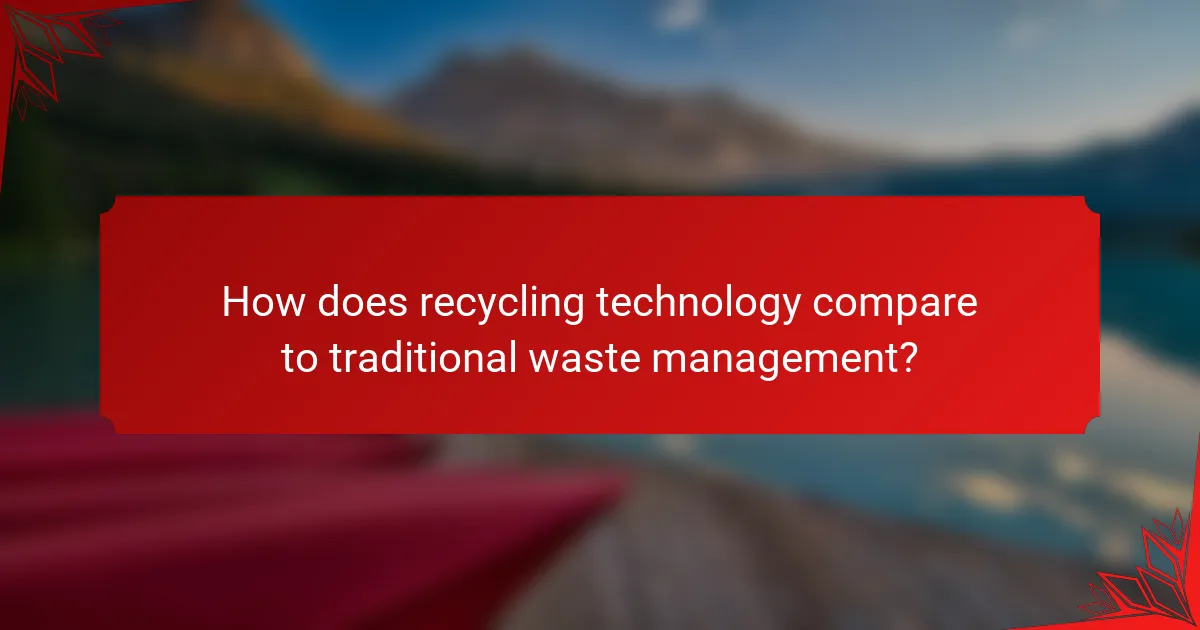
How does recycling technology compare to traditional waste management?
Recycling technology generally offers advantages over traditional waste management by reducing costs, increasing efficiency, and providing significant environmental benefits. It transforms waste into reusable materials, minimizing landfill use and promoting sustainability.
Cost-effectiveness analysis
Recycling technology can be more cost-effective than traditional waste management methods in the long run. While initial investments in recycling facilities and technology may be high, the savings from reduced landfill fees and the sale of recycled materials can offset these costs. Many municipalities have found that implementing recycling programs leads to lower overall waste management expenses.
For example, cities that invest in advanced recycling technologies often see a decrease in waste disposal costs by up to 30%. This is particularly relevant in regions where landfill space is limited or expensive.
Efficiency metrics
Efficiency in recycling technology is measured by the rate at which materials are processed and the quality of the output. Advanced sorting systems and automated processing can significantly enhance the speed and accuracy of recycling operations. These systems can process thousands of tons of waste per day, compared to traditional methods that may only handle a fraction of that amount.
Moreover, recycling technologies can achieve higher purity levels in recycled materials, which is crucial for manufacturers looking for quality inputs. This efficiency not only reduces operational costs but also increases the market value of recycled products.
Environmental impact comparison
Recycling technology has a markedly lower environmental impact compared to traditional waste management. By diverting waste from landfills, recycling reduces greenhouse gas emissions and conserves natural resources. For instance, recycling aluminum saves about 90% of the energy required to produce new aluminum from raw materials.
Additionally, recycling helps to minimize pollution associated with waste disposal. It supports a circular economy, where materials are reused rather than discarded, leading to a more sustainable approach to resource management. Regions that prioritize recycling often see improvements in air and water quality as a result of reduced landfill use.
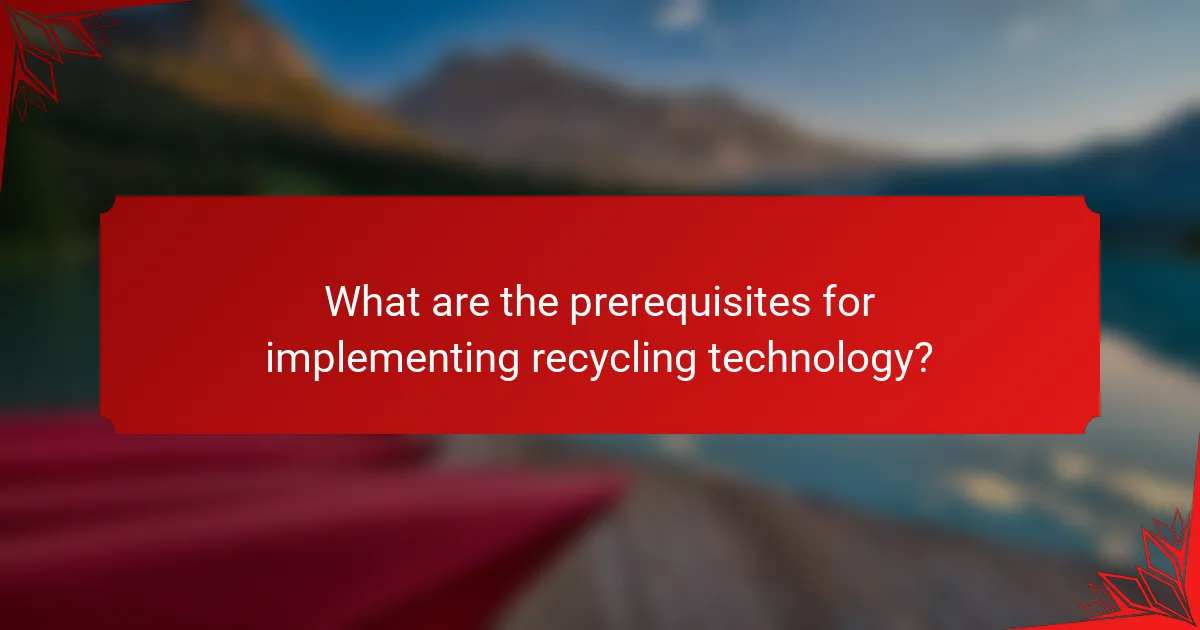
What are the prerequisites for implementing recycling technology?
Implementing recycling technology requires a solid foundation of infrastructure, adherence to regulatory standards, and careful financial planning. These prerequisites ensure that recycling initiatives are efficient, compliant, and sustainable.
Infrastructure requirements
Effective recycling technology relies on robust infrastructure, including collection systems, processing facilities, and transportation networks. Communities must have accessible recycling bins and efficient logistics to transport materials to processing centers.
For instance, urban areas may need centralized recycling facilities, while rural regions might benefit from mobile collection units. Investing in modern sorting technology can also enhance material recovery rates and reduce contamination.
Regulatory compliance
Compliance with local and national regulations is crucial for implementing recycling technology. This includes understanding waste management laws, environmental protection standards, and any specific recycling mandates that may apply.
For example, the European Union has established directives that set recycling targets for member states. Organizations must stay informed about these regulations to avoid penalties and ensure their recycling practices align with legal requirements.
Investment considerations
Investing in recycling technology involves evaluating both initial costs and long-term savings. Expenses may include purchasing equipment, upgrading facilities, and training staff. However, effective recycling can lead to reduced waste disposal costs and potential revenue from selling recycled materials.
It is advisable to conduct a cost-benefit analysis to understand the financial implications. Additionally, exploring grants or incentives for sustainable practices can help offset initial investments and promote a more circular economy.
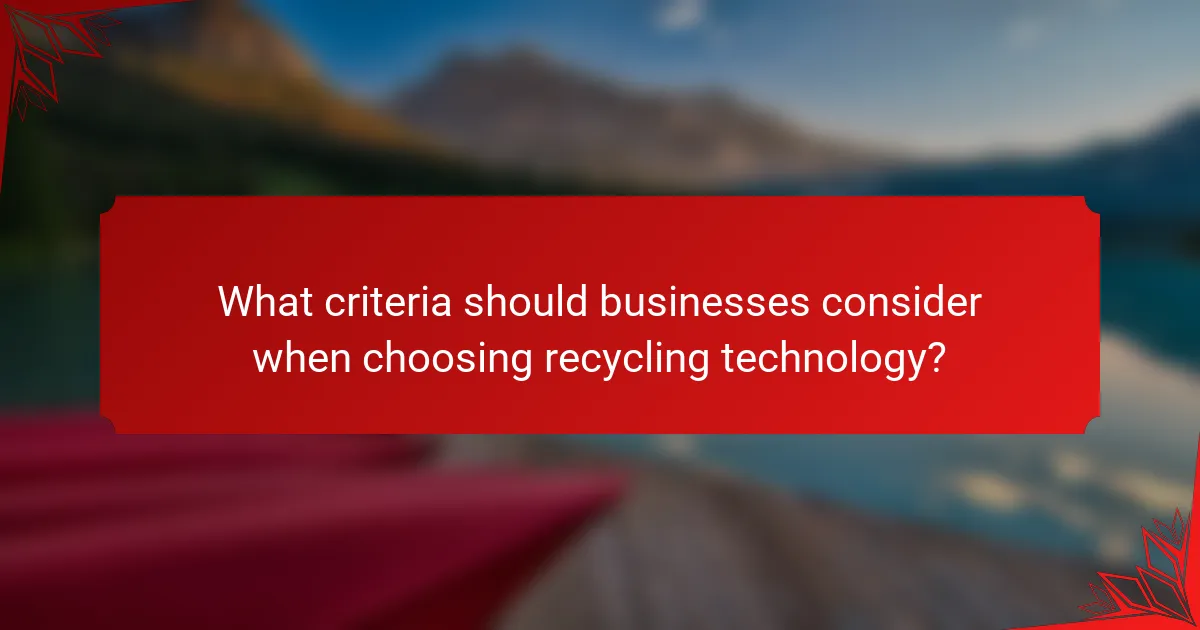
What criteria should businesses consider when choosing recycling technology?
Businesses should consider technology scalability, vendor reputation, and cost versus benefit analysis when selecting recycling technology. These factors help ensure that the chosen solution meets current needs while being adaptable for future growth and efficiency improvements.
Technology scalability
Scalability refers to a technology’s ability to grow and adapt to increasing volumes of waste or changing materials. Businesses should assess whether the recycling technology can handle future demands without requiring a complete overhaul. For instance, a system that can be upgraded with additional modules or components is often more beneficial than one that is fixed in capacity.
When evaluating scalability, consider the projected growth of your waste stream. If you anticipate significant increases, opt for systems that can expand easily, such as those that allow for additional sorting or processing capabilities. This foresight can prevent costly replacements down the line.
Vendor reputation
Choosing a reputable vendor is crucial for ensuring reliable service and support. Researching a vendor’s history, customer reviews, and industry standing can provide insights into their reliability and the quality of their technology. A vendor with a strong track record is more likely to offer effective solutions and responsive customer service.
Engage with other businesses in your industry to gather feedback on their experiences with specific vendors. This peer insight can be invaluable in making an informed decision. Additionally, consider vendors that offer warranties or service agreements, as these can enhance long-term satisfaction and reduce unexpected costs.
Cost vs. benefit analysis
A thorough cost versus benefit analysis helps businesses understand the financial implications of adopting new recycling technology. This analysis should include initial investment costs, ongoing operational expenses, and potential savings from improved efficiency and reduced waste disposal fees. It’s essential to weigh these factors against the environmental benefits and compliance with local regulations.
To conduct an effective analysis, create a detailed breakdown of all costs associated with the technology, including maintenance and training. Compare these costs to the expected benefits, such as reduced landfill fees or increased material recovery rates. A well-rounded assessment will help in making a financially sound decision that aligns with sustainability goals.
